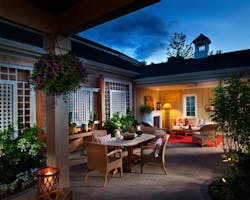More Americans courting indoor-outdoor living
The courtyard, an ancient concept for bringing natural light into homes while preserving privacy, is in full flower in America today as lots get tighter and the popularity of outdoor rooms increases. Courtyard homes have been around for years in those parts of the U.S. that get plentiful sunlight for a good part of the year (such as California and Colorado). But there’s no reason a home in Massachusetts or Minnesota can’t have one too, as long as it’s designed properly.
Obviously a courtyard has to be sited where it will get the most sun. Trees provide shade on hot days, and water simultaneously cools the space through evaporation and has a calming effect. An article in last Friday’s Wall Street Journal noted that courtyards work with any architectural style, even though many people associate them with Mediterranean homes.
Courtyards can have a variety of features, from cascading fountains and rock gardens to built-in barbecue pits and swimming pools. New building technology has also heightened their livability and functionality, notes WSJ. For example, folding window walls can be opened to make the courtyard an extension of the home. LED lighting can be used to set the mood for each course of a dinner party. Retractable screens keep annoying insects at bay. Heated pavers make the walk from house to hot tub more comfortable on a chilly night.
Luxury touches aside, courtyards aren’t limited to high-end homes. It’s living space that doesn’t have to be cooled or heated, and it psychologically makes a smaller home feel larger. The Green Company of Newton, Mass., is one of many builders who has used courtyards to expand the perception of space in small homes (see Fresco at The Pinehills). You might also want to check out “Homes and Courtyards," published by Bassenian Lagoni Architects of Newport Beach, Calif., in 2007.

